 W
WEl Abra is the name given to an extensive archeological site, located in the valley of the same name. El Abra is situated in the east of the municipality Zipaquirá extending to the westernmost part of Tocancipá in the department of Cundinamarca, Colombia. The several hundred metres long series of rock shelters is in the north of the Bogotá savanna on the Altiplano Cundiboyacense, Eastern Ranges of the Colombian Andes at an altitude of 2,570 metres (8,430 ft). The rock shelter and cave system is one of the first evidences of human settlement in the Americas, dated at 12,400 ± 160 years BP. The site was used by the hunter-gatherers of the Late Pleistocene epoch.
 W
WBluefish Caves is an archaeological site in Yukon, Canada, located 54 km (34 mi) southwest of the Vuntut Gwichin community of Old Crow, from which a human-worked jaw bone of a Yukon horse has been radiocarbon dated to 24,000 years before present (BP), earlier than the generally accepted age for habitation of the New World. There are 3 small caves in the area.
Buttermilk Creek Complex refers to the remains of a paleolithic settlement along the shores of Buttermilk Creek in present-day Salado, Texas dated to approximately 15,500 years old. If confirmed, the site represents evidence of human settlement in the Americas that pre-dates the Clovis culture.
 W
WThe Calico Early Man Site is an archaeological site in an ancient Pleistocene lake located near Barstow in San Bernardino County in the central Mojave Desert of southern California. This site is on and in late middle-Pleistocene fanglomerates known variously as the Calico Hills, the Yermo Hills, or the Yermo formation. Holocene evidence includes petroglyphs and trail segments that are probably related to outcrops of local high-quality siliceous rock.
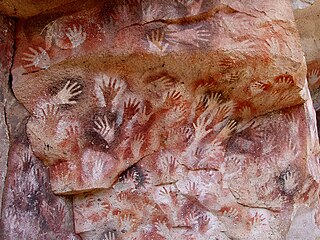 W
WCueva de las Manos is a cave or a series of caves located in the province of Santa Cruz, Argentina, 163 km (101 mi) south of the town of Perito Moreno. It is famous for the paintings of hands on its walls. The art in the cave dates from 13,000 to 9,000 years ago, which would put it in Archaic Period of South American history, during the Paleolithic era. More specifically, the art exists during the late Pleistocine and early Holocine periods. Several waves of people occupied the cave, and early artwork has been carbon-dated to ca. 9300 BP. The age of the paintings was calculated from the remains of bone-made pipes used for spraying the paint on the wall of the cave to create silhouettes of hands. According to Fanning et al., it is "the best material evidence of early hunter gatherer groups in South America".
 W
WThe Delmarva Peninsula, or simply Delmarva, is a large peninsula on the East Coast of the United States, occupied by the vast majority of the state of Delaware and parts of the Eastern Shore regions of Maryland and Virginia. The peninsula is 170 miles (274 km) long. In width, it ranges from 70 miles (113 km) near its center, to 12 miles (19 km) at the isthmus on its northern edge, to less near its southern tip of Cape Charles. It is bordered by the Chesapeake Bay on the west, and the Delaware River, Delaware Bay, and the Atlantic Ocean on the east.
 W
WFort Rock Cave was the site of the earliest evidence of human habitation in the US state of Oregon before the excavation of Paisley Caves. Fort Rock Cave featured numerous well-preserved sagebrush sandals, ranging from 9,000 to 13,000 years old. The cave is located approximately 1.5 miles (2.4 km) west of Fort Rock near Fort Rock State Natural Area in Lake County. Fort Rock Cave was declared a National Historic Landmark in 1961, and added to the National Register of Historic Places in 1966.
 W
WThe Gault archaeological site is an extensive, multicomponent site located in central Texas, United States, about 40 miles (64 km) north of Austin. It bears evidence of almost continuous human occupation, starting at least 16,000 years ago—making it one of the few archaeological sites in the Americas at which compelling evidence has been found for human occupation dating to before the appearance of the Clovis culture.
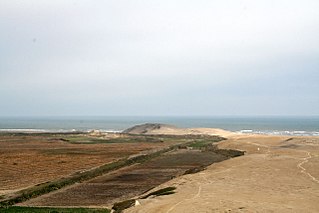 W
WHuaca Prieta is the site of a prehistoric settlement beside the Pacific Ocean in the Chicama Valley , just north of Trujillo, La Libertad Province, Peru. It is a part of the El Brujo Archaeological Complex, which also includes Moche (culture) sites.
 W
WHueyatlaco is an archeological site in the Valsequillo Basin near the city of Puebla, Mexico. After excavations in the 1960s, the site became notorious due to geochronologists' analyses that indicated human habitation at Hueyatlaco was dated to ca. 250,000 years before the present.
 W
WKenosha is a city in and the county seat of Kenosha County, Wisconsin, United States. Kenosha is on the southwestern shore of Lake Michigan. With an estimated population of 99,944 as of 1 July 2019, it is the fourth-largest city in Wisconsin and the fourth-largest city on Lake Michigan. Although closer to Milwaukee, the city is part of the United States Census Bureau's Chicago combined statistical area (CSA) and metropolitan statistical area.
 W
WLamb Spring is a pre-Clovis prehistoric Paleo-Indian archaeological site located in Douglas County, Colorado with the largest collection of Columbian mammoth bones in the state. Lamb Spring also provides evidence of Paleo-Indian hunting in a later period by the Cody culture complex group. Lamb Spring was listed in 1997 on the National Register of Historic Places.
 W
WLittle John is an archaeological site in Yukon, Canada, located 25 km (16 mi) northwest of the White River First Nation community of Beaver Creek, from which human artefacts and ancient animal bones have been radiocarbon dated to 14,000 years before present (BP), earlier than the generally accepted time for human migration into the Americas and one of the oldest sites in Beringia.
 W
WThe Manis Mastodon site is a 2-acre (1 ha) archaeological site on the Olympic Peninsula near Sequim, Washington, United States. During the dig, the remains of an American mastodon were recovered which had a 13,800 year old projectile made of the bone from a different mastodon embedded in its rib. The site was placed on the National Register of Historic Places in 1978.
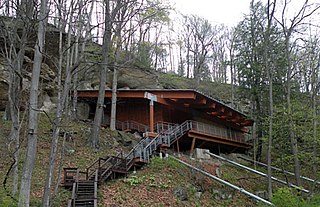 W
WMeadowcroft Rockshelter is an archaeological site located near Avella in Jefferson Township, Washington County, Pennsylvania, United States. The site is a rock shelter in a bluff overlooking Cross Creek, and contains evidence that the area may have been continually inhabited for more than 19,000 years. If accurately dated, the site would be the earliest known evidence of human presence and the longest sequence of continuous human occupation in the New World.
 W
WMonte Verde is an archaeological site in southern Chile, located near Puerto Montt, Southern Chile, which has been dated to as early as 18,500 cal BP. Previously, the widely accepted date for early occupation at Monte Verde was ~14,500 years cal BP. This dating added to the evidence showing that the human settlement of the Americas pre-dates the Clovis culture by roughly 1000 years. This contradicts the previously accepted "Clovis first" model which holds that settlement of the Americas began after 13,500 cal BP. The Monte Verde findings were initially dismissed by most of the scientific community, but the evidence then became more accepted in archaeological circles.
 W
WEve of Naharon is the skeleton of a 20– to 25-year-old human Mayan female found in the Naharon section of the underwater cave Sistema Naranjal in Mexico near the town of Tulum, around 80 miles (130 km) south west of Cancún. The Naranjal subsystem is a part of the larger Sistema Ox Bel Ha. The skeleton is carbon dated to 13,600 years ago, which makes it one of the oldest documented human finds in the Americas.
 W
WOld Crow Flats is a 6,170 km2 (2,382 sq mi) wetland complex in northern Yukon, Canada along the Old Crow River. It is north of the Arctic Circle and south of the Beaufort Sea, and is nearly surrounded by mountains.
 W
WOn Your Knees Cave (49-PET-408) is an archaeological site located in southeastern Alaska. Human remains were found at the site in 1996 that dated between 9,730 ±60 and 9,880±50 radiocarbon YBP or a calendrical date of 10,300 YBP. In addition to human skeletal remains, stone tools and animal bones were discovered. DNA analyses performed on the human skeletal remains document the presence of mitochondrial haplogroup D which occurs widely in the Americas. Isotopic analysis indicated that the individual had a primarily marine based diet.
 W
WOña Canton is a canton of Ecuador, located in the Azuay Province. Its capital is the town of Oña, Ecuador. Its population at the 2001 census was 3,231.
 W
WThe Paisley Caves complex is a system of four caves in an arid, desolate region of south-central Oregon, United States north of the present-day city of Paisley, Oregon. The caves are located in the Summer Lake basin at 4,520 feet (1,380 m) elevation and face to the west in a ridge of Miocene and Pliocene era basalts mixed with soft volcanic tuffs and breccias, from which the caves were carved by Pleistocene-era waves from Summer Lake. One of the caves may contain archaeological evidence of the oldest definitively-dated human presence in North America. The site was first studied by Luther Cressman in the 1930s.
 W
WPedra Furada is an important collection of over 800 archaeological sites in the state of Piauí, Brazil. These include hundreds of rock paintings dating from circa 12,000 years before present. More importantly, charcoal from very ancient fires and stone shards that may be interpreted as tools found at the location were dated from 48,000 to 32,000 years before present, suggesting the possibility of a human presence tens of thousand of years prior to the arrival of the Clovis people in North America.
 W
WPiki Mach'ay is an archaeological site in the Ayacucho Valley of Peru. Radiocarbon dates from this cave give a human presence ranging from 22,200 to 14,700 years ago, but this evidence has been disputed and a more conservative date 12,000 years BCE seems possible.
 W
WPilauco is a paleontological and archaeological site located in the city of Osorno in Southern Chile. The site contains both human made lithic artifacts and megafauna remains–including gomphotheres. All the horizons containing megafauna and evidence of human activity date to the late Pleistocene. The calibrated radiocarbon dates indicate human evidences between 16,400 and -12,800 cal years B.P.
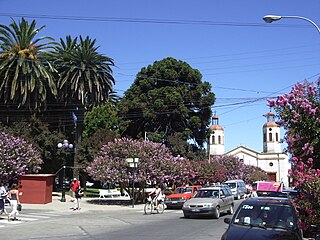 W
WSan Vicente de Tagua Tagua, or just San Vicente, is a Chilean commune and city in Cachapoal Province, O'Higgins Region.
 W
WSanta Rosa Island is the second largest of the Channel Islands of California at 53,195 acres. Santa Rosa is located about 26 miles (42 km) off the coast of Santa Barbara, California in Santa Barbara County and is part of Channel Islands National Park.
 W
WSauce is a small city and municipality in the Canelones Department of southern Uruguay.
 W
WSerra da Capivara National Park is a national park in the Northeastern region of Brazil. The area has many prehistoric paintings.
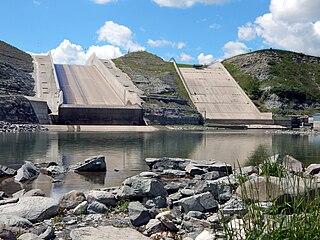 W
WSt. Mary Reservoir is a reservoir in southwestern Alberta, Canada. It was created for irrigation purposes by the damming of the St. Mary River, which was completed in 1951. The Kainai Nation's Blood 148 Indian reserve borders its northwest side. There are camping and picnic areas at the reservoir, and it is a popular site for power boating, water skiing, windsurfing, swimming and fishing.
 W
WTaima-Taima is a Late Pleistocene archaeological site located about 20 kilometers east of Santa Ana de Coro, in the Falcón State of Venezuela. The human settlement at Taima-Taima started about 14,000 years ago.
 W
WTibitó is the second-oldest dated archaeological site on the Altiplano Cundiboyacense, Colombia. The rock shelter is located in the municipality Tocancipá, Cundinamarca, Colombia, in the northern part of the Bogotá savanna. At Tibitó, bone and stone tools and carbon have been found. Bones from Haplomastodon, Cuvieronius, Cerdocyon and white tailed deer from the deepest human trace containing layer of the site is carbon dated to be 11,740 ± 110 years old. The oldest dated sediments are lacustrine clays from an ancient Pleistocene lake.
 W
WTlapacoya is an important archaeological site in Mexico, located at the foot of the Tlapacoya volcano, southeast of Mexico City, on the former shore of Lake Chalco. Tlapacoya was a major site for the Tlatilco culture.
 W
WToca da Tira Peia is a rock shelter site, located in the municipality Coronel José Dias, Piauí state, near the Serra da Capivara National Park, Brazil, thought to hold evidence of prehistoric human presence in South America dating to 22,000 years ago.
 W
WTriquet Island is an island off the west coast of British Columbia, Canada. It is south of Hunter and Campbell Islands facing the open Queen Charlotte Sound to the west. The island is administered as part of the Central Coast Regional District. The climate of the area is temperate. Average annual temperature is approximately 6.9 °C (44.4 °F).